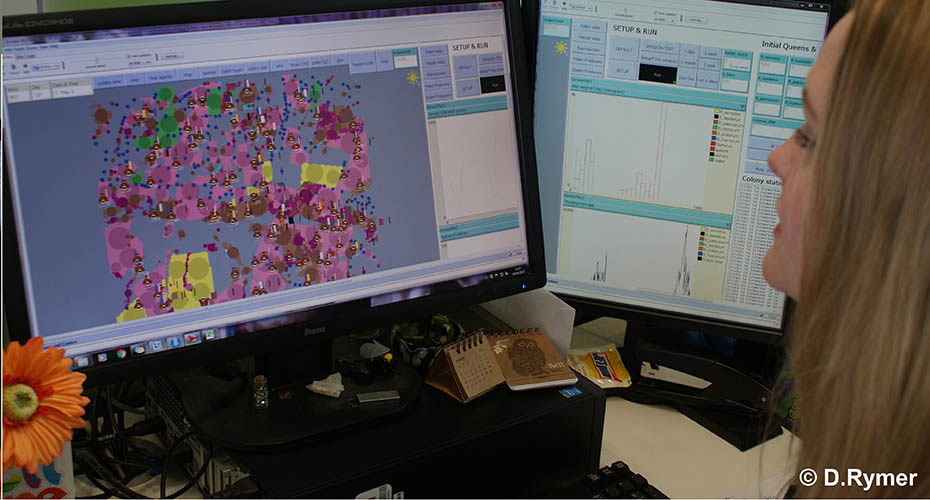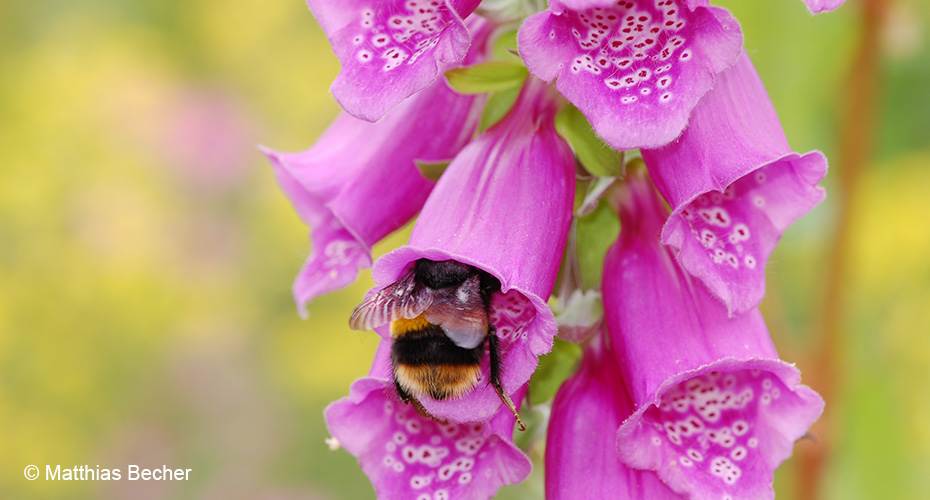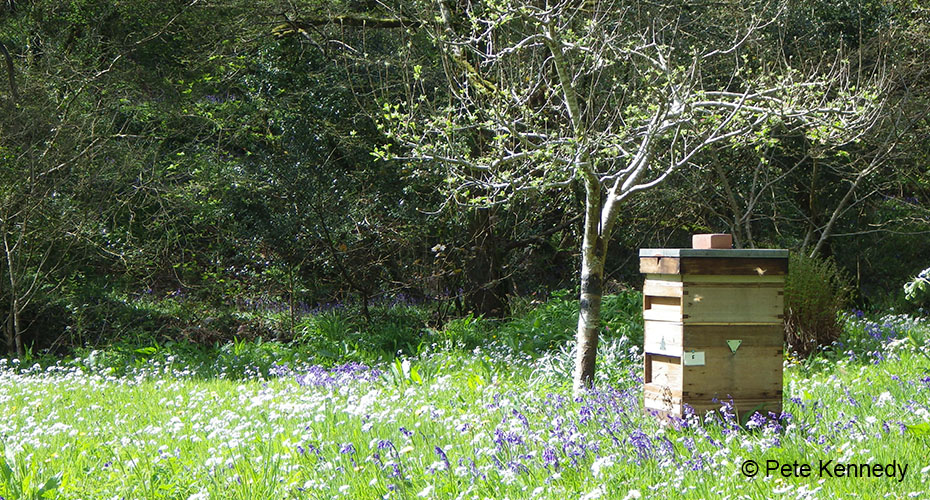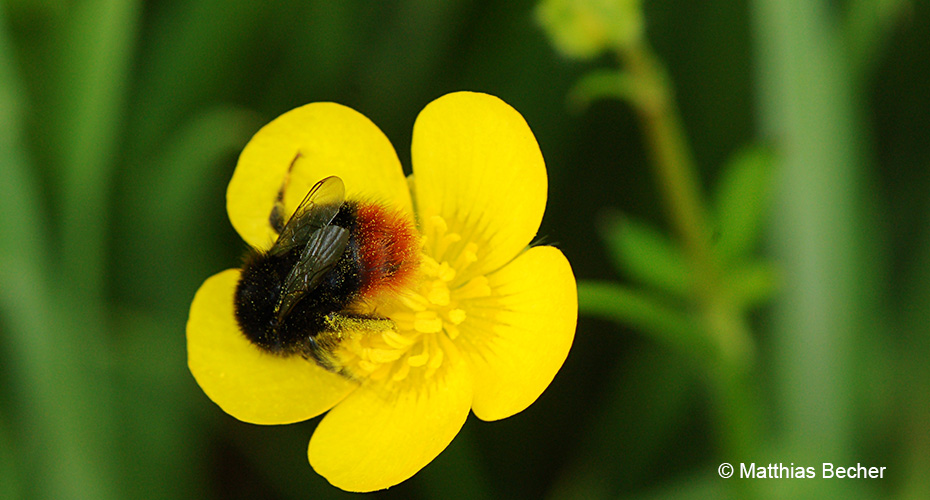Virtual bee models helping to deliver benefits for pollinators
Research overview:
Pollinators – including bees – are in decline globally, posing a substantial threat to global food production and to insect and plant biodiversity. Research from Professor Juliet Osborne and colleagues has played a pivotal role in identifying threats to pollinators, with a focus on loss of habitat, disease, invasive species, climate change and pesticide use.
Realising the importance of predicting the impact of multiple stressors on pollinator population dynamics over long time frames (years) and large spatial scales (km), the ESI Pollinator group have developed innovative ecological models of managed and wild bee colony dynamics to forecast bee colony survival. The “BEEHAVE” model has changed how regulators assess risks to honeybees and set bee protection goals in the EU, and the “BEE-STEWARD” model, focussed on bumblebees, has enabled the delivery of pollinator-friendly plans for land managers across the UK.
Key objectives:
- Developing innovative ecological decision-support tools for use by stakeholders, in pursuit of an improved environment for pollinators.
- Predicting the impact of multiple stressors on pollinator populations over long time frames and large spatial scales.
- Improved European regulation and informed land management.
Impact:
The suite of models and strong translation activities of the group are actively building pollinator resilient environments both locally and globally.
The resulting science underpins national pollinator policy and European regulation on bee protection, and enables global industry to reduce the environmental damage of pesticides.
The research impacts the practice of land stewards and local government to manage landscapes to maximise pollinator survival. For example, BEE-STEWARD it is being used in Bumblebee Conservation Trust’s project: The Fowey Valley Bumblebee Project.

It is vital that we understand how different factors interact to affect both wild bees and managed honeybees. Field experiments are essential to determine how bees respond to landscape changes, and how this affects their colonies. But such experiments are usually limited to one season and a few field sites. This is where creating a virtual bee world can help us. Our complex, ecologically realistic bee models enable us to create virtual landscapes with honeybee and bumblebee colonies. We can run the models changing different factors like flower availability, disease pressure or even pesticide mortalities. The simulations give us a clear idea of how likely bee colonies are to survive under different scenarios. They are therefore really important as decision-support tools for land-owners and other stakeholders. They are a very useful research tool.
Prof Juliet Osborne
Twiston‐Davies, G., Becher, M. A., & Osborne, J. L. (2021). BEE‐STEWARD: A research and decision‐support software for effective land management to promote bumblebee populations. Methods in Ecology and Evolution, 12(10), 1809-1815. doi:10.1111/2041-210x.13673
Becher, M. A., Twiston-Davies, G., Penny, T. D., Goulson, D., Rotheray, E. L., & Osborne, J. L. (2018). Bumble-BEEHAVE: A systems model for exploring multifactorial causes of bumblebee decline at individual, colony, population and community level. Journal of Applied Ecology, 55(6), 2790-2801. doi:10.1111/1365-2664.13165
Becher, M. A., Grimm, V., Knapp, J., Horn, J., Twiston-Davies, G., & Osborne, J. L. (2016). BEESCOUT: A model of bee scouting behaviour and a software tool for characterizing nectar/pollen landscapes for BEEHAVE. Ecological Modelling, 340, 126-133. doi:10.1016/j.ecolmodel.2016.09.013
BEEHAVE website: www.beehave-model.net.
Rumkee, J. C. O., Becher, M. A., Thorbek, P., Kennedy, P. J., & Osborne, J. L. (2015). Predicting Honeybee Colony Failure: Using the BEEHAVE Model to Simulate Colony Responses to Pesticides. Environmental Science and Technology, 49(21), 12879-12887. doi:10.1021/acs.est.5b03593
Fürst, M. A., McMahon, D. P., Osborne, J. L., Paxton, R. J., & Brown, M. J. F. (2014). Disease associations between honeybees and bumblebees as a threat to wild pollinators. Nature, 506(7488), 364-366. doi:10.1038/nature12977
Becher, M. A., Grimm, V., Thorbek, P., Horn, J., Kennedy, P. J., & Osborne, J. L. (2014). BEEHAVE: A systems model of honeybee colony dynamics and foraging to explore multifactorial causes of colony failure. Journal of Applied Ecology, 51(2), 470-482. doi:10.1111/1365-2664.12222
Methods Blog: Creating a research and conservation tool to support pollinator survival (August 2021)
earth.com: "Virtual safe space" could help save bees (August 2021)
BBSRC: Bee survival model adopted by industry (March 2018)




